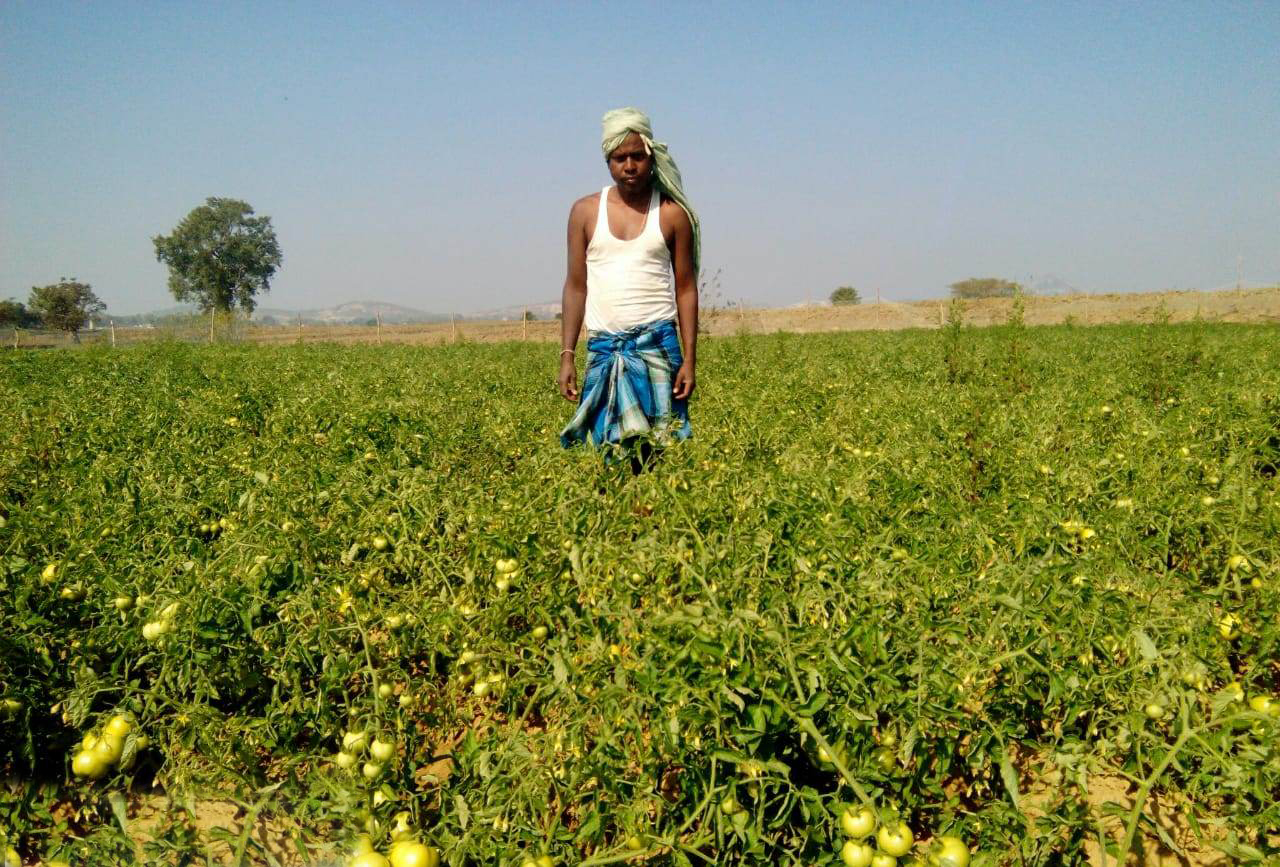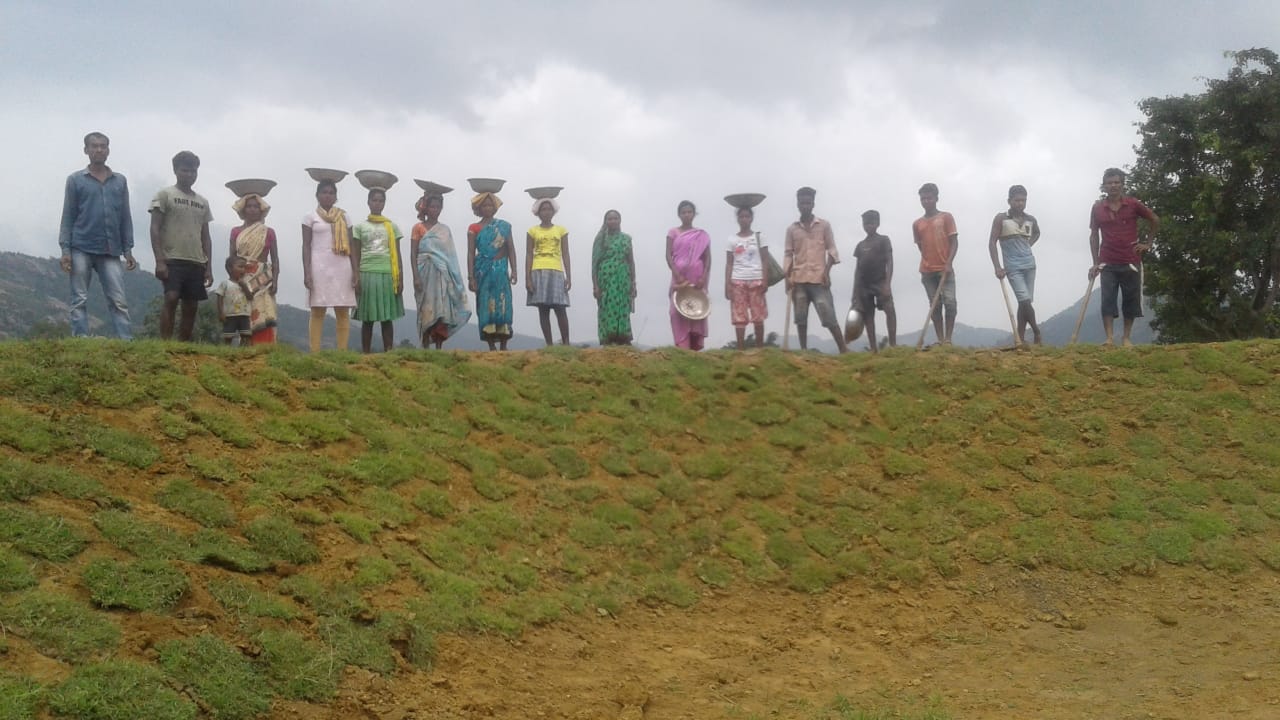- The farmers in Gumla and Simdega districts of Jharkhand were suffering from severe water crisis and soil erosion till a few years ago.
- The state government along with non-profit chipped in and started watershed management by excavating trenches along the hill slopes in 2012.
- Over 25,000 people in two districts have been benefitted from trenches that have led to multiple cropping due to adequate supply of water.
Umesh Kumar is a young farmer at Pithra village in Simdega district in Jharkhand, a picturesque village surrounded by hills and green forest cover. The 26-year-old owns around 12 acres of land, where he grows various vegetables and wheat almost around the year.
He beams with joy on seeing an earthen check dam near his lush green fields. “The multiple crops in the fields have been the gift of this earthen check dam that has been providing water to my farmland. The rise in income has helped me to send my two children to English medium schools which seemed to be a distant dream even a year ago,” said Kumar.
Kumar claims that his income has almost doubled since trenches were excavated along the hill close to his field around six months ago, “Earlier, the vegetables grown were for home consumption but now an increase in production has helped me to sell them in the market. It has also become possible to do multiple cropping because of the earthen check dam that keeps the soil perennial for cultivation,” he added in a telephonic conversation.
Over 90 percent of the total 5000 population in Pithra village is involved in farming. They are witnessing a rise in income since the trenches were dug in the hill slopes of the village around six months ago.

State government decided to dig trenches in 2012
The excavation of trenches has been part of the watershed management project that was implemented in 30 villages across two districts, Simdega and Gumla, of Jharkhand by the state government in collaboration with Social Action for Rural Development (SARDA), a non-profit working for community-based rural livelihoods as an executing agency.
“It has been helping the farmers by ensuring less to no irrigation as the soil remains moist due to seepage of water and also preventing soil erosion that destroys the standing crops in the fields,” said N.P. Singh, founder of SARDA.
He said that the project was implemented in the villages of Simdega and Gumla in 2012 and 2013 respectively, after realising the severe water crisis in the area and other issues, “The region suffers from severe water shortage and the situation becomes worse during extreme summers. It used to become difficult for farmers to continue farming. They had to remain content with the single crop which was not enough. It often resulted in hunger and starvation.”

Debasish De, a Bengal-based specialist in natural resource management said that the trenches are being excavated to tap the flowing rainwater, “The farmers nowadays are excavating staggered, contour and continuous trenches, water absorption trenches based on the geographical configuration of that area. The dug up trenches along the hillside not only taps the rainwater that could have gone waste but also prevents soil erosion. The stored water in the trenches seeps in the earth making the soil perennial for cultivation while the percolation of water recharges the groundwater level.”
He further pointed out, “Majority of the farmers depend on traditional farming and face losses if the rains are deficit. The excavation of trenches is a need of an hour because the rainfalls are becoming erratic with each passing year due to global warming. The trenches also play a major part in preventing the loss of topsoil that could have been taken away by the flowing water.”
Several hectares of wasteland made productive
As per the data made available by SARDA, around 200,000 (2 lakh) trenches have been excavated in two districts covering 30 villages in Jharkhand since the project kicked-off in 2012.
Singh says that the water conservation done in these villages ensures a constant supply of water across the year, “We have treated around 1500 hectares of land and conserved around 800 crore litres of water in both the districts. Nearly 800 to 1000 hectares of land has been transformed from waste to cultivable land and around 700 hectares has been brought under cultivation.”
The concept of watershed management had started from Ralegaon in Maharashtra to cope up with the scarcity of water in 1975.
In Jharkhand, it was started in 2012 and has been initiated in other states of the country as well.
Read more: Ecosystems-based adaptation keeps water running in Bhojdari even in dry months
Rise in groundwater level
Arjun Mahato, 35, a farmer who lives at Goja village in Gumla district in Jharkhand says that water conservation has helped in increasing the water level of wells and other water bodies in the village, “Earlier, the rainwater used to runoff and there was a severe water crisis for farming during summers. We had to wait for the rains for farming. We had to depend on a single crop for livelihood which was not enough. But trenches have changed our lives. There is also ample water level in wells and ponds mostly across the year preventing women to take a long walk for water.”

Sujit Kumar, a farmer in Pithra village is planning to start fish farming during rains, “The ponds near the trench have adequate water for fish farming. It can be an extra source of income for me. The state had deficit rains last year but fish farming could be an option if the rains are ample this year.”
Inadequate rainfall in Jharkhand
Jharkhand suffers from a deficit of rains. The Central government had declared 10 districts of Jharkhand as drought-affected last year, impacting 1200,000 (12 lakh) farmers of the state.
The cumulative rainfall in Jharkhand from June 1 to August 23 last year was 541.6 mm against the ideal amount of 754.3 mm causing a deficit of 28 percent over the entire state. The state is feared to face severe water shortage, this year.
Out of 24 districts in Jharkhand, seven had received normal rainfall, 16 have received below normal rainfall whereas one district, Godda, had received scanty rainfall with 62 percent deficit in 2019.
Creating livelihood through SHGs
As part of the holistic development of the area under watershed management, livestock has been distributed among farmers and Self Help Groups (SHGs) have been formed for creating livelihood opportunities mostly for women.
Sonal Guriya, a member of an SHG at Bindhartolli village in Simdega district says that she was trained in making handicraft items in 2014, “We were trained around six years ago in making different kinds of item like table covers, bamboo baskets and incense sticks among others. We earn our livelihood by selling them in local markets and even online.”

“The watershed management has created livelihood opportunities in the areas that were infamous for Maoist activities. Several people were employed in the excavation of trenches and working as a labour in the fields due to multiple cropping,” said Junul Samad, technical expert (district), rural development.
“The government has replicated the watershed management project in all the districts of Jharkhand.”
Banner image: A rally being taken out to create awareness on watershed management in Simdega district. Photo courtesy Social Action For Rural Development (SARDA).













